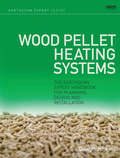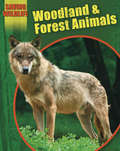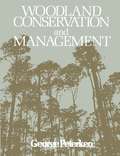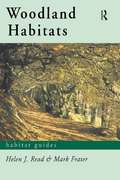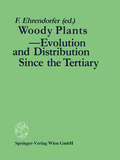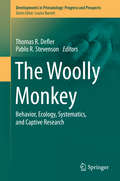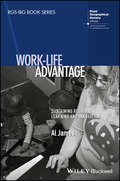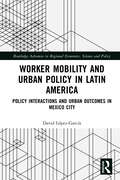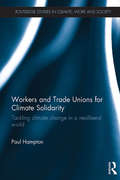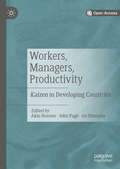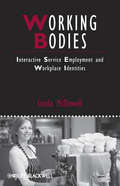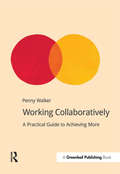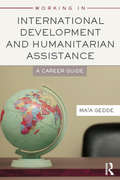- Table View
- List View
Wood Pellet Heating Systems: The Earthscan Expert Handbook on Planning, Design and Installation (Earthscan Expert Ser.)
by Dilwyn JenkinsWood Pellet Heating Systems is a comprehensive handbook covering all aspects of wood pellet heating technology. The use of wood pellets as an alternative heating fuel is already well established in several countries and is becoming widespread as fossil fuel prices continue to rise and awareness of climate change grows. Wood pellets are a carbon-neutral technology, convenient to use, and can easily be integrated into existing central heating systems or used in independent space heaters. This fully-illustrated and easy-to-follow guide shows how wood-pellet heating works, the different types of systems – from small living room stove systems to larger central heating systems for institutions – how they are installed, and even how wood pellets are manufactured. Featuring examples from around the world, it has been written for heating engineers and plumbers who are interested in installing systems, home owners and building managers who are considering purchasing a system, advanced DIYers, building engineers and architects, but will be of interest to anyone who requires a clear guide to wood pellet technology.
Woodland and Forest Animals: Woodland And Forest Animals (Saving Wildlife)
by Sonya NewlandWoodland & Forest Animals studies creatures under threat in woodland areas, and looks at how conservation is reversing damage caused by human activity and natural disasters.It is part of the Saving Wildlife series, which investigates the world's endangered species in the context of their different environments.
Woodland Conservation and Management
by G. F. PeterkenProfessor John Harper, in his recent Population Biology of Plants (1977), made a comment and asked a question which effectively states the theme of this book. Noting that 'one of the consequences of the development of the theory of vegetational climax has been to guide the observer's mind forwards', i. e. that 'vegetation is interpreted asa stage on the way to something', he commented that 'it might be more healthy and scientifically more sound to look more often backwards and search for the explanation of the present in the past, to explain systems in relation to their history rather than their goal'. He went on to contrast the 'disaster theory' of plant succession, which holds that communities are a response to the effects of past disasters, with the 'climax theory', that they are stages in the approach to a climax state, and then asked 'do we account most completely for the characteristics of a population by a knowledge of its history or of its destiny?' Had this question been put to R. S. Adamson, E. J. Salisbury, A. G. Tansley or A. S. Watt, who are amongst the giants of the first forty years of woodland ecology in Britain, their answer would surely have been that understanding lies in a knowledge of destiny. Whilst not unaware of the historical facts of British woodlands, they were preoccupied with ideas of natural succession and climax, and tended to interpret their observations in these terms.
Woodland Flowers: Colourful past, uncertain future (British Wildlife Collection)
by Keith KirbyObserving the plants of the forest floor – the flowers, ferns, sedges and grasses – can be a vital way of understanding our relationship with British woodland. They tell us stories about its history and past management, and can be a visible sign of progress when we get conservation right. For centuries, woodland plants have also been part of our lives in practical ways as food and medicines, and they have influenced our culture through poetry, perfume and pub signs.In this insightful and original account, Keith Kirby explores how woodland plants in Great Britain have come to be where they are, coped with living in the shade of their bigger relatives, and responded to threats in the form of storms, fires, floods, the attentions of grazing herbivores and the effects of the changing seasons. Along the way, the reader is introduced to the work of important botanists who have walked the woods in the past, collecting information on where plants occur and why. In-depth profiles of some of our most important and popular ground flora species provide extra detail and insight. Beautifully illustrated, Woodland Flowers is a must for anyone who appreciates and wants to learn more about British woodland and its plants.
Woodland Flowers: Colourful past, uncertain future (British Wildlife Collection)
by Keith KirbyObserving the plants of the forest floor – the flowers, ferns, sedges and grasses – can be a vital way of understanding our relationship with British woodland. They tell us stories about its history and past management, and can be a visible sign of progress when we get conservation right. For centuries, woodland plants have also been part of our lives in practical ways as food and medicines, and they have influenced our culture through poetry, perfume and pub signs.In this insightful and original account, Keith Kirby explores how woodland plants in Great Britain have come to be where they are, coped with living in the shade of their bigger relatives, and responded to threats in the form of storms, fires, floods, the attentions of grazing herbivores and the effects of the changing seasons. Along the way, the reader is introduced to the work of important botanists who have walked the woods in the past, collecting information on where plants occur and why. In-depth profiles of some of our most important and popular ground flora species provide extra detail and insight. Beautifully illustrated, Woodland Flowers is a must for anyone who appreciates and wants to learn more about British woodland and its plants.
Woodland Habitats (Habitat Guides)
by Mark Frater Helen J. ReadWoodland habitats explores the history and ecology of British woodland and explains why they a re such a valuable resource. It examines the wide range of different types of woodland habitats and the typical species that live within them. It offers a practical guide to all the key woodland issues including: *conservation and management * coppicing * grazing in woodlands * fire breaks * recreation * management for game * pasture woodland and commercial forestry Woodland Habitats also includes a guide to notable sites with location maps and illustrations, suggested practical projects and a full glossary of terms.
Woodland Habitats (Habitat Guides)
by Mark Frater Helen J. ReadWoodland habitats explores the history and ecology of British woodland and explains why they a re such a valuable resource. It examines the wide range of different types of woodland habitats and the typical species that live within them. It offers a practical guide to all the key woodland issues including: *conservation and management * coppicing * grazing in woodlands * fire breaks * recreation * management for game * pasture woodland and commercial forestry Woodland Habitats also includes a guide to notable sites with location maps and illustrations, suggested practical projects and a full glossary of terms.
Woody Plants - Evolution and Distribution Since the Tertiary: Proceedings of a Symposium Organized by Deutsche Akademie der Naturforscher LEOPOLDINA in Halle/Saale, German Democratic Republic, October 9-11, 1986
by Friedrich EhrendorferThe Woolly Monkey: Behavior, Ecology, Systematics, and Captive Research (Developments in Primatology: Progress and Prospects #Vol. 39)
by Thomas R. Defler Pablo R. StevensonWoolly monkeys are large, attractive and widespread primates found throughout many parts of the Amazon basin. It is only in the last twenty-five years or so that long-term studies of woollies in their forest habitat have been successful; they have not generally been successfully kept in captivity. But now, especially because of their size, these creatures are pressed on all sides by bush meat hunters and forest fragmentation. Their future is becoming critically precarious and the editors feel that it is time to showcase these animals with a full book.The editors draw together a number of recent woolly monkey studies from three Amazonian countries, including five taxa of woolly monkeys, four of which have recently been reclassified without using new biological criteria as species rather than subspecies (Groves, 2001, 2005; Rylands & Mittermeier, 2009). This volume provides a diversity of studies by well-known researchers and advanced students on a wide range of subjects using newly generated data, including a criticism of the recent taxonomic changes. The varied information contained within The Woolly Monkey: Behavior, Ecology, Systematics and Captive Research will help readers understand these handsome animals and will, we hope, energize them to contribute to their conservation.
Work-Life Advantage: Sustaining Regional Learning and Innovation (RGS-IBG Book Series)
by Al JamesWork-Life Advantage analyses how employer-provision of ‘family-friendly’ working arrangements - designed to help workers better reconcile work, home and family - can also enhance firms’ capacities for learning and innovation, in pursuit of long-term competitive advantage and socially inclusive growth. Brings together major debates in labour geography, feminist geography, and regional learning in novel ways, through a focus on the shifting boundaries between work, home, and family Addresses a major gap in the scholarly research surrounding the narrow ‘business case’ for work-life balance by developing a more socially progressive, workerist ‘dual agenda’ Challenges and disrupts masculinist assumptions of the “ideal worker” and the associated labour market marginalization of workers with significant home and family commitments Based on 10 years of research with over 300 IT workers and 150 IT firms in the UK and Ireland, with important insights for professional workers and knowledge-intensive companies around the world
Work-Life Advantage: Sustaining Regional Learning and Innovation (RGS-IBG Book Series)
by Al JamesWork-Life Advantage analyses how employer-provision of ‘family-friendly’ working arrangements - designed to help workers better reconcile work, home and family - can also enhance firms’ capacities for learning and innovation, in pursuit of long-term competitive advantage and socially inclusive growth. Brings together major debates in labour geography, feminist geography, and regional learning in novel ways, through a focus on the shifting boundaries between work, home, and family Addresses a major gap in the scholarly research surrounding the narrow ‘business case’ for work-life balance by developing a more socially progressive, workerist ‘dual agenda’ Challenges and disrupts masculinist assumptions of the “ideal worker” and the associated labour market marginalization of workers with significant home and family commitments Based on 10 years of research with over 300 IT workers and 150 IT firms in the UK and Ireland, with important insights for professional workers and knowledge-intensive companies around the world
The Work of Management: A Leader’s Guide to Applying Systems Leadership
by Ian Macdonald Catherine Burke Karl StewartThe Work of Management demonstrates how the concepts, models and tools of Systems Leadership can be applied, enabling you to become a more effective manager by improving your own work to create a more positive and effective organisation.Positive organisations, where people come together to achieve a productive and personally satisfying purpose, and which provide the basis for a good society, do not occur by chance. They are created by the work of leaders and members who are dependent upon the way the organisation is designed and operates – its structure and systems. While the theory is explained, this book primarily presents the practical aspects – the specific values, methods and tools – that can be used to improve work and the work performance of direct reports. Building on the bestselling book Systems Leadership, this book provides leaders with a manual for the application of concepts as well as an introduction to Systems Leadership Theory, a method that has been used successfully by businesses from large multinational firms and banks, to SMEs, public agencies and NGOs. It provides a predictive capability, allowing a leader to predict what will work well and what is likely to fail, according to the context. It gives the benefit of foresight as decisions must be made.Designed as a leader’s manual for the application of the concepts around Systems Leadership, this book is for people who want to improve their own, and their organisation’s, work practices and performance.
The Work of Management: A Leader’s Guide to Applying Systems Leadership
by Ian Macdonald Catherine Burke Karl StewartThe Work of Management demonstrates how the concepts, models and tools of Systems Leadership can be applied, enabling you to become a more effective manager by improving your own work to create a more positive and effective organisation.Positive organisations, where people come together to achieve a productive and personally satisfying purpose, and which provide the basis for a good society, do not occur by chance. They are created by the work of leaders and members who are dependent upon the way the organisation is designed and operates – its structure and systems. While the theory is explained, this book primarily presents the practical aspects – the specific values, methods and tools – that can be used to improve work and the work performance of direct reports. Building on the bestselling book Systems Leadership, this book provides leaders with a manual for the application of concepts as well as an introduction to Systems Leadership Theory, a method that has been used successfully by businesses from large multinational firms and banks, to SMEs, public agencies and NGOs. It provides a predictive capability, allowing a leader to predict what will work well and what is likely to fail, according to the context. It gives the benefit of foresight as decisions must be made.Designed as a leader’s manual for the application of the concepts around Systems Leadership, this book is for people who want to improve their own, and their organisation’s, work practices and performance.
Worker Mobility and Urban Policy in Latin America: Policy Interactions and Urban Outcomes in Mexico City (Routledge Advances in Regional Economics, Science and Policy)
by David López-GarcíaThis book argues that urban outcomes are better understood as the result of the interactions between policies from distinct policy domains rather than from any single policy silo. In doing so, the book develops and applies the Policy Interactions Framework to the study of the mobility experience of workers in Greater Mexico City. Four empirical studies provide the reader with a comprehensive view of how urban policies can sometimes interact at cross-purposes to produce inequitable urban outcomes. The chapters analyze time and distance in the journey to work to quantify and map commuting inequalities, assess the shift in the spatial location of the demand for labor between 1999 and 2019, examine the default housing pathways available for workers, and evaluate the spatial distribution of public and common mobility resources. An outcome of applying the Policy Interactions Framework to the study of workers’ mobility is to put forward the choiceless mobility hypothesis: a process by which the interaction between the spatial location of the demand for labor, the housing pathways available for workers, and the political economy of public transport operates to produce geographies of low accessibility to jobs. The audience of this book consists of scholars and practitioners in the field of urban policy analysis, urban development, and urban political economy in the Global South.
Worker Mobility and Urban Policy in Latin America: Policy Interactions and Urban Outcomes in Mexico City (Routledge Advances in Regional Economics, Science and Policy)
by David López-GarcíaThis book argues that urban outcomes are better understood as the result of the interactions between policies from distinct policy domains rather than from any single policy silo. In doing so, the book develops and applies the Policy Interactions Framework to the study of the mobility experience of workers in Greater Mexico City. Four empirical studies provide the reader with a comprehensive view of how urban policies can sometimes interact at cross-purposes to produce inequitable urban outcomes. The chapters analyze time and distance in the journey to work to quantify and map commuting inequalities, assess the shift in the spatial location of the demand for labor between 1999 and 2019, examine the default housing pathways available for workers, and evaluate the spatial distribution of public and common mobility resources. An outcome of applying the Policy Interactions Framework to the study of workers’ mobility is to put forward the choiceless mobility hypothesis: a process by which the interaction between the spatial location of the demand for labor, the housing pathways available for workers, and the political economy of public transport operates to produce geographies of low accessibility to jobs. The audience of this book consists of scholars and practitioners in the field of urban policy analysis, urban development, and urban political economy in the Global South.
Workers and Trade Unions for Climate Solidarity: Tackling climate change in a neoliberal world (Routledge Studies in Climate, Work and Society)
by Paul HamptonThis book is a theoretically rich and empirically grounded account of UK trade union engagement with climate change over the last three decades. It offers a rigorous critique of the mainstream neoliberal and ecological modernisation approaches, extending the concepts of Marxist social and employment relations theory to the climate realm. The book applies insights from employment relations to the political economy of climate change, developing a model for understanding trade union behaviour over climate matters. The strong interdisciplinary approach draws together lessons from both physical and social science, providing an original empirical investigation into the climate politics of the UK trade union movement from high level officials down to workplace climate representatives, from issues of climate jobs to workers’ climate action. This book will be of great interest to students and researchers in environmental politics, climate change and environmental sociology.
Workers and Trade Unions for Climate Solidarity: Tackling climate change in a neoliberal world (Routledge Studies in Climate, Work and Society)
by Paul HamptonThis book is a theoretically rich and empirically grounded account of UK trade union engagement with climate change over the last three decades. It offers a rigorous critique of the mainstream neoliberal and ecological modernisation approaches, extending the concepts of Marxist social and employment relations theory to the climate realm. The book applies insights from employment relations to the political economy of climate change, developing a model for understanding trade union behaviour over climate matters. The strong interdisciplinary approach draws together lessons from both physical and social science, providing an original empirical investigation into the climate politics of the UK trade union movement from high level officials down to workplace climate representatives, from issues of climate jobs to workers’ climate action. This book will be of great interest to students and researchers in environmental politics, climate change and environmental sociology.
Workers, Managers, Productivity: Kaizen in Developing Countries
by Akio Hosono John Page Go ShimadaThis open access book provides a glimpse into the Japanese management technique known as “Kaizen,” and the ways it has been disseminated around the developing world. The novelty of this book is three-fold: it provides a contextualized view of the mechanisms of initiatives implementing Kaizen in developing countries; compared with productivity studies, it places the relationship between workers and managers at the center of inquiry, reflecting the intent of SDG8 concerning decent work and economic growth; and it provides an overview of the heterogeneity of Kaizen in terms of geography and firm size. This book explores how improving management techniques can support firms’ productivity and quality. Given its wide range of case studies from across Africa, Asia and Latin America, this book will be of value to scholars, policymakers and advocates of sustainable development alike.
Workers of the Earth: Labour, Ecology and Reproduction in the Age of Climate Change
by Stefania BarcaCapitalism is destroying our planet, but like most social progress in the last two centuries, ecological justice can only be achieved through working-class struggle.In Workers of the Earth, Stefania Barca uncovers the environmental history and political ecology of labour to shed new light on the potentiality of workers as ecological subjects. Taking an ecofeminist approach, this ground-breaking book makes a unique contribution to the emerging field of environmental labour studies, expanding the category of labour to include waged and unwaged, industrial and meta-industrial workers.Going beyond conventional categories of ‘production’ and ‘reproduction’ as separate spheres of human experience, Barca offers a fresh perspective on the place of labour in today’s global climate struggle, reminding us that the fight against climate change is a fight against capitalism.
Working Bodies: Interactive Service Employment and Workplace Identities (IJURR Studies in Urban and Social Change Book Series #61)
by Linda McDowellThrough a series of case studies of low-status interactive and embodied servicing work, Working Bodies examines the theoretical and empirical nature of the shift to embodied work in service-dominated economies. Defines ‘body work’ to include the work by service sector employees on their own bodies and on the bodies of others Sets UK case studies in the context of global patterns of economic change Explores the consequences of growing polarization in the service sector Draws on geography, sociology, anthropology, labour market studies, and feminist scholarship
Working Bodies: Interactive Service Employment and Workplace Identities (IJURR Studies in Urban and Social Change Book Series)
by Linda McDowellThrough a series of case studies of low-status interactive and embodied servicing work, Working Bodies examines the theoretical and empirical nature of the shift to embodied work in service-dominated economies. Defines ‘body work’ to include the work by service sector employees on their own bodies and on the bodies of others Sets UK case studies in the context of global patterns of economic change Explores the consequences of growing polarization in the service sector Draws on geography, sociology, anthropology, labour market studies, and feminist scholarship
Working Collaboratively: A Practical Guide to Achieving More
by Penny WalkerThe really big sustainability challenges for your business can’t be solved by your business. But they can be solved by your business working in collaboration with others. Working Collaboratively provides tools to help you understand and manage successful collaborations: identify potential collaborators, e.g. key players from other parts of the system; spot internal "ways of working" that support or get in the way of collaboration; use a range of techniques to explore win-wins with potential collaborators. Collaboration means sharing decisions, resources, risks... and control. It means trusting others, sharing your weaknesses as well as your strengths and taking the time to find win-wins (or compromises). It requires a leap of faith, because you never know what will emerge from the chaotic early steps. Drawing on examples of collaboration between strange bedfellows, this practical guide will help you take the first steps towards building sustainable solutions together.
Working Collaboratively: A Practical Guide to Achieving More (Doshorts Ser.)
by Penny WalkerThe really big sustainability challenges for your business can’t be solved by your business. But they can be solved by your business working in collaboration with others. Working Collaboratively provides tools to help you understand and manage successful collaborations: identify potential collaborators, e.g. key players from other parts of the system; spot internal "ways of working" that support or get in the way of collaboration; use a range of techniques to explore win-wins with potential collaborators. Collaboration means sharing decisions, resources, risks... and control. It means trusting others, sharing your weaknesses as well as your strengths and taking the time to find win-wins (or compromises). It requires a leap of faith, because you never know what will emerge from the chaotic early steps. Drawing on examples of collaboration between strange bedfellows, this practical guide will help you take the first steps towards building sustainable solutions together.
Working in International Development and Humanitarian Assistance: A Career Guide
by Maia GeddeThis is an indispensable career guide for everyone wanting to work in or already working in the international development and humanitarian emergencies sector. It provides a general introduction and insight into the sector, for those exploring it as a potential career, and offers students up-to-date advice when choosing a course, whether it’s at undergraduate or postgraduate level. Should they study International Development, or will Public Health, Environmental studies or Media get them closer to where they want to get? This book offers graduates or career changers who are new to the sector an understanding of what skills and experience will make them stand out above the competition and get that job. It enables those already working in the sector to gain a long term view of where they want to go and how they might structure their professional development to gain the skills and competencies necessary to get their career on to an upward trajectory. This book draws heavily on insiders’ advice, case studies and top tips, to provide the reader with various perspectives and insights. How do you become a country director for an international NGO? How can one become a gender mainstreaming expert? What can you do to get in to consultancy? Career trajectories, Career clinics Q&A boxes and the personal planner in the appendix will help you get to where you want to go. It also gives a detailed account of the myriad of careers and specialism available within the sector and methodologically describes the pros and cons of each option. So if you are not sure where you want to go with your career, you will be after you have read this book. Whether it’s Programme Management, becoming an Environmental Advisor, or an Acadmic this book will give you an insight into what the job entails and how you can get in to it. It will be an invaluable guide to all readers, irrespective of their country of origin, who are interested in the sector.
Working in International Development and Humanitarian Assistance: A Career Guide
by Maia GeddeThis is an indispensable career guide for everyone wanting to work in or already working in the international development and humanitarian emergencies sector. It provides a general introduction and insight into the sector, for those exploring it as a potential career, and offers students up-to-date advice when choosing a course, whether it’s at undergraduate or postgraduate level. Should they study International Development, or will Public Health, Environmental studies or Media get them closer to where they want to get? This book offers graduates or career changers who are new to the sector an understanding of what skills and experience will make them stand out above the competition and get that job. It enables those already working in the sector to gain a long term view of where they want to go and how they might structure their professional development to gain the skills and competencies necessary to get their career on to an upward trajectory. This book draws heavily on insiders’ advice, case studies and top tips, to provide the reader with various perspectives and insights. How do you become a country director for an international NGO? How can one become a gender mainstreaming expert? What can you do to get in to consultancy? Career trajectories, Career clinics Q&A boxes and the personal planner in the appendix will help you get to where you want to go. It also gives a detailed account of the myriad of careers and specialism available within the sector and methodologically describes the pros and cons of each option. So if you are not sure where you want to go with your career, you will be after you have read this book. Whether it’s Programme Management, becoming an Environmental Advisor, or an Acadmic this book will give you an insight into what the job entails and how you can get in to it. It will be an invaluable guide to all readers, irrespective of their country of origin, who are interested in the sector.
